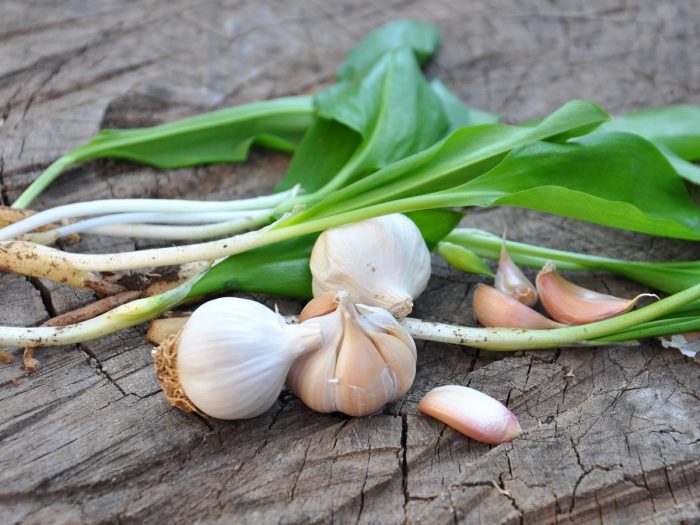If you’ve never cooked with wild garlic, you are missing out on a delicious and widely available element to your everyday cooking. That being said, knowing how to identify and use wild garlic is also very important.
Table of Contents
What is Wild Garlic?
Wild garlic is a collection of species in the Allium genus that have some of the same characteristics as normal garlic cloves. There are quite a few different plants that fall under the title wild garlic, including some wild onion varieties. Some of the different names for wild garlic include Allium ursinum, ramsons, buckrams, broad-leaved garlic, wood garlic, bear leek, bear’s garlic, field garlic, Drummond’s onion, and crow garlic. While each of these names technically describes different species, they tend to be classified together. [8]
This form of garlic grows extensively throughout North America, particularly on the majority of the eastern half of the United States, and parts of the west coast. You can find field garlic in backyards, wooded areas, disturbed soil, and even manicured lawns. Once you are able to identify these wild edibles, you can add them to your health regimen in a number of ways. [9]

Wild garlic has an intense flavor. Photo Credit: Shutterstock
How to Identify Wild Garlic?
It can be difficult to identify this wild form of garlic, as many people find that it looks quite similar to grass. However, there are some clear differences, including the hollow nature of the long, narrow leaves, which tend to grow in bunches, roughly 1-3 feet in height. The hollow leaves resemble chives, and are often mistaken for green onions; in fact, the flavor is often quite similar, and these two herbs are commonly mistaken for one another. [10]
Beneath the ground, as with more traditional types of garlic, this wild variety of garlic will have a collection of stems and small bulbs. If you want to avoid pulling up the roots to identify a plant, look for the dense clusters of umbrella-shaped flowers, which can be an indicator of a wild garlic patch. To guarantee that you have found some type of Allium genus wild garlic, you can break or bruise the leaves, which should then release the recognizable smell of onions/garlic.
Medicinal Uses of Wild Garlic
Medicinally speaking, there are many impressive uses for wild garlic, including in the treatment of high blood pressure, high cholesterol, stomach upset, and chronic disease, among others. This type of garlic can be used internally or topically as an herbal supplement or added to poultices and other home remedies.
Improves Heart Health
Garlic is known to have a soothing effect on high blood pressure, which can lessen your risk of atherosclerosis, heart attacks, and strokes. Furthermore, wild garlic is able to lower overall cholesterol levels, keeping your heart in good shape as you age. [11]
Treats Stomach Issues
The antibacterial and anti-fungal compounds found in this wilder form of garlic can help to re-balance the bacterial flora in your gut, which can soothe inflammation, bloating, cramping, constipation, and other stomach issues you may be handling. [12]
Anticancer Potential
Wild garlic can help in protecting you from cancer in many ways. According to a 2018 study, it helps in inhibiting the formation of cancer-causing substances and also enhances DNA repair. Wild garlic also helps in inducing cancer cell death, thereby lowering your risk of suffering from cancer. [13]
One more research paper has also shown that wild garlic also has the potential to kill skin cancer cells. [14]
A 2015 study reveals that the presence of diallyl disulfide, an active ingredient in ramson volatile oil, helps in inhibiting the proliferation of human cancer cell lines, including breast, prostate, lung, colon cancers, lymphomas, and neuroblastoma. [15]
Culinary Uses of Wild Garlic
Most people use this garlic as a substitute or complement to normal garlic or onions in a dish. While the flavor may be slightly milder than a sliced up garlic clove, it can still make an impact in any meal. The leaves are often sliced to mimic chives or green onions, while the small bulbs can be minced or added to a stir-fry for an extra kick of flavor. You can add them to soups, stews, and curries, or even sprinkle ground-up wild garlic in salads and marinades for chicken and beef dishes.
